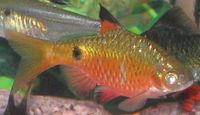Difference between revisions of "Pethia conchonius"
From The Aquarium Wiki
(Tried a third time to fix broken link.) |
(Tried a fourth time to fix brokren link) |
||
| Line 72: | Line 72: | ||
*[[w:Rosy barb|Wikipedia]] | *[[w:Rosy barb|Wikipedia]] | ||
*[http://www.aquahobby.com/gallery/e_rosy.php Aqua Hobby] | *[http://www.aquahobby.com/gallery/e_rosy.php Aqua Hobby] | ||
| − | *[http:www.bettatrading.com.au/Rosy-Barb-Fact-Sheet.php Rosy Barb Fact Sheet] | + | *[http://www.bettatrading.com.au/Rosy-Barb-Fact-Sheet.php Rosy Barb Fact Sheet] |
Revision as of 05:02, 25 September 2017
Rosy Barb
Pethia conchonius
76 Litres (20 US G.)
7.6-10.2cm (3-4 ")
Freshwater
7.2 - 7.8
18 -25 °C (64.4-77°F)
5-15 °d
1:2 M:F
3-4 years
Family
Cyprinidae
This animal is available captive bred
Contents
Additional names
- Rosy Barb, Red Barb
Additional scientific names
- Barbus conchonius, Cyprinus conchonius, Puntius conchonius khagariansis, Systomus conchonius, Systomus pyropterus, Systomus pyrrhopterus, Puntius conchonius
Origin
- Found throughout Afghanistan, Pakistan, India, Nepal, and Bangladesh. There have been reports of it in Myanmar.[1]
Sexing
- Males are green towards the dorsal fin, females are redder. Males have black spots on the dorsal fin, also their fins grow quite long.
Tank compatibility
- One of the most peaceful of the Barbs, but just to be safe, do not keep with slow-moving or long-finned fish such as Bettas and Angelfish as they still may be fin nipped. Keep in shoaling groups of 5 or more, more females than males if mixed sexes.
Diet
- Will accept most foods including pellet and flake as well as live/frozen food such as bloodworm and brine shrimp.
Feeding regime
- Feed once or twice a day.
Environment Specifics
- Fairly hardy towards most tank environments. Keep in a spacious tank with ample open swimming space as well as hiding places.
Behaviour
- One of the more peaceful Barbs that is unlikely to be aggressive towards tank mates, especially if kept in a shoal. It should be remembered that this fish can get bigger than many community fish, and to be careful not to keep fish with a major difference in size in the same tank.
Identification
- The Rosy Barb has no barbels and has slight lateral compression. The back is copper to green-gold, the flanks are bright orange to red and metallic looking. Near the caudal peduncle is a black spot. The reddish fins may be elaborate with the anal and dorsal fins have black borders along the upper-parts. Males turn a deep, but bright red colour at spawning times.
Pictures
Videos
References
External links
- Fishbase (Mirrors:
 )
)


